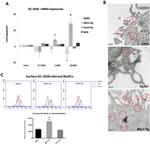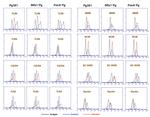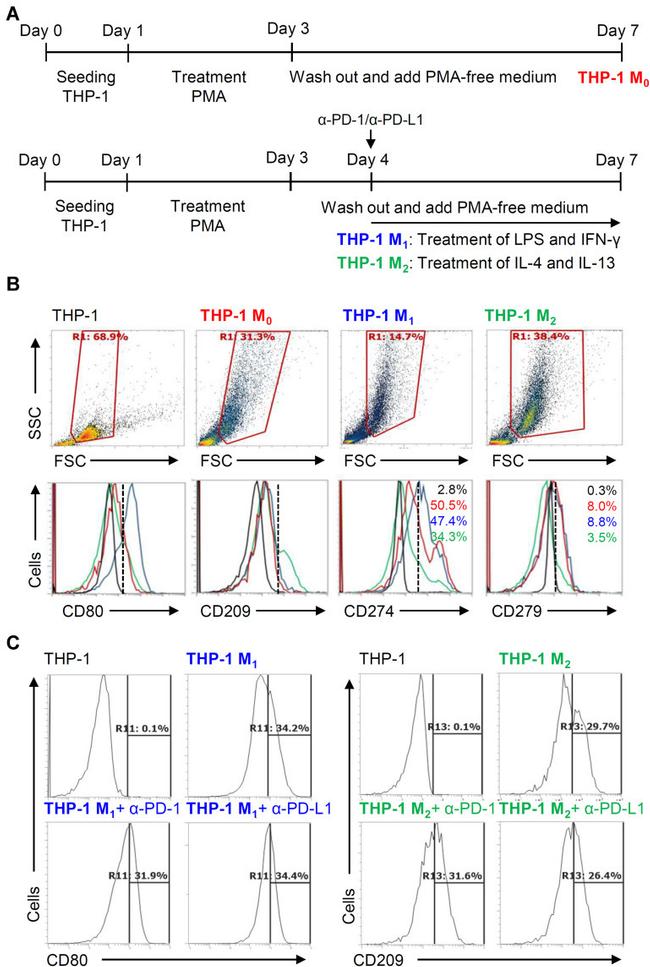Invitrogen
CD209 (DC-SIGN) Monoclonal Antibody (eB-h209), Biotin, eBioscience™
FIGURE: 1 / 3
CD209 (DC-SIGN) Antibody (13-2099-82) in Flow



Product Details
13-2099-82
Species Reactivity
Published species
Host/Isotype
Recommended Isotype Control
Class
Type
Clone
Conjugate
Form
Concentration
Purification
Storage buffer
Contains
Storage conditions
Shipping conditions
RRID
Product Specific Information
Description: The eB-h209 monoclonal antibody reacts with human CD209, also known as DC-SIGN, a 44 kDa type II transmembrane protein. DC-SIGN contains a C-type lectin binding domain and binds ICAM-3, ICAM-2, and HIV virus. Human dendritic cells preferentially express DC-SIGN. It has been postulated that DC-SIGN serves as a receptor for capture, trafficking, and transmission of HIV to T cells and supports primary immune response. eB-h209 was developed against a C-terminal peptide of human DC-SIGN.
Applications Reported: The eB-h209 antibody has been reported for use in flow cytometric analysis.
Applications Tested: The eB-h209 antibody has been tested by flow cytometric analysis of cultured human dendritic cells and peripheral blood cells This can be used at less than or equal to 1 µg per test. A test is defined as the amount (µg) of antibody that will stain a cell sample in a final volume of 100 µL. Cell number should be determined empirically but can range from 10^5 to 10^8 cells/test. It is recommended that the antibody be carefully titrated for optimal performance in the assay of interest.
Filtration: 0.2 µm post-manufacturing filtered.
Target Information
This gene encodes a transmembrane receptor and is often referred to as DC-SIGN because of its expression on the surface of dendritic cells and macrophages. The encoded protein is involved in the innate immune system and recognizes numerous evolutionarily divergent pathogens ranging from parasites to viruses with a large impact on public health. The protein is organized into three distinct domains: an N-terminal transmembrane domain, a tandem-repeat neck domain and C-type lectin carbohydrate recognition domain. The extracellular region consisting of the C-type lectin and neck domains has a dual function as a pathogen recognition receptor and a cell adhesion receptor by binding carbohydrate ligands on the surface of microbes and endogenous cells. The neck region is important for homo-oligomerization which allows the receptor to bind multivalent ligands with high avidity. Variations in the number of 23 amino acid repeats in the neck domain of this protein are rare but have a significant impact on ligand binding ability. This gene is closely related in terms of both sequence and function to a neighboring gene (GeneID 10332; often referred to as L-SIGN). DC-SIGN and L-SIGN differ in their ligand-binding properties and distribution. Alternative splicing results in multiple variants.
For Research Use Only. Not for use in diagnostic procedures. Not for resale without express authorization.
Bioinformatics
Protein Aliases: C-type lectin domain family 4 member L; C-type lectin domain family 4, member L; CD209; CD209 antigen; DC-SIGN; Dendritic cell-specific ICAM-3-grabbing non-integrin 1; dendritic cell-specific intercellular adhesion molecule-3-grabbing non-integrin; dendritic cell-specific intracellular adhesion molecules (ICAM)-3 grabbing non-integrin; HIV gpl20-binding protein; MGC129965; MGC130443
Gene Aliases: CD209; CDSIGN; CLEC4L; DC-SIGN; DC-SIGN1
UniProt ID: (Human) Q9NNX6
Entrez Gene ID: (Human) 30835

Performance Guarantee
If an Invitrogen™ antibody doesn't perform as described on our website or datasheet,we'll replace the product at no cost to you, or provide you with a credit for a future purchase.*
Learn more
We're here to help
Get expert recommendations for common problems or connect directly with an on staff expert for technical assistance related to applications, equipment and general product use.
Contact tech support
